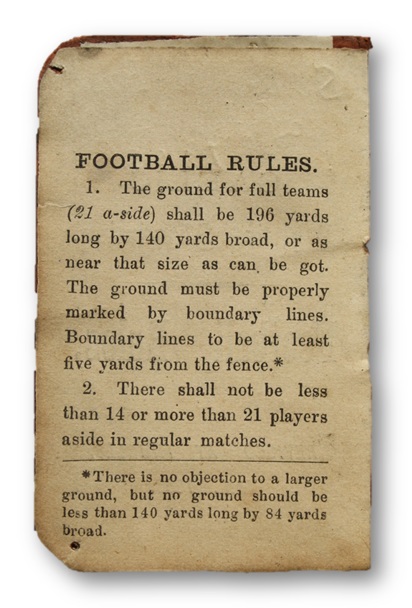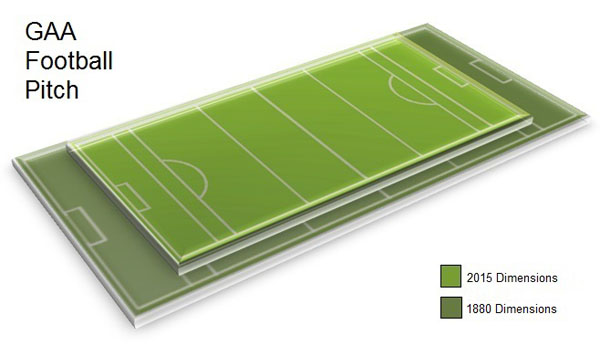1888
Gaelic Athletic Association Football Rules Book 1888
GAA football rules as revised at Thurles, County Tipperary in January, 1888
By Noel CampbellDescription
This small GAA football rules book measures only 7.5cm high and 5cm wide. The original red book cover, now badly faded, contained similar wording to the books title page (above). The body of the book comprises of 12 pages which detail 13 football rules as adopted by the GAA in January, 1888.
The Gaelic Athletic Association established
In 1884, the Gaelic Athletic Association was set up to regulate and promote Ireland’s national games. As a result, GAA football or Gaelic football became the third form of football to be codified in Ireland, after soccer and rugby. Although Gaelic football played a minor role compared to athletics and hurling in the GAA’s early years, football became increasingly popular. This popularity demanded a specific rule book be written to regulate the many football games being played throughout Ireland.

What football rules were set down in January, 1888?
The first rules of Gaelic football were set down in February, 1885. The rules proved too vague and additions and clarifications were needed.
1888’s Rule 1 defined the size of the playing pitch. The ground for full teams (21 a-side) would be 196 yards long by 140 yards broad. 2015 pitch dimensions for 15-a side are 158 yards long and 98 yards wide.
Rule 4 detailed that there shall be an upright post standing 21 feet from each goal post on the goal line. A goal was scored when the ball went between goal posts and under the crossbar. A point, when the ball went over the crossbar or over the goal line within 21 feet of either goal post. In a change from today’s practice, Rule 5 stated that immediately prior to throw in, each team will stand in two ranks opposite each other in the centre of the field, each holding the hand of one of the other side. Matches would be decided by the greater number of goals. When the amount of goals were even, it was decided on the greater number of points.
The success of early Gaelic football
Some early GAA patrons viewed football in any form as a foreign game. The GAA’s hierarchy were conscious and wary of Gaelic football’s similarities with rugby and despite agreeing similar rules, they attempted to combat any links. There were however prominent members such as Dick Blake, chairman of the Meath county board, that believed the game should borrow the best features of both rugby and soccer in an attempt to make Gaelic football more attractive to GAA patrons and players.

How did the National Museum of Ireland acquire this object?
The original owner Sylvester Roche from Drogheda, County Louth printed his name on the book’s title page and included the date ’29 January 1888’. Through P. Duffy, Secretary of Louth GAA, Mr. Roche presented the book to Padraig Ó Caoimh, General Secretary of the GAA from 1929-64. Mr. Ó Caoimh donated the book to the National Museum of Ireland in 1942. This book is registered F:1942.1818.
Learn More
Breheny, Martin & Keenan, Donal, 2001. The Ultimate Encyclopedia of Gaelic Football & Hurling, London: Carlton Books Limited
Carey, Tim, 2007. Croke Park A History, Cork: The Collins Press
De Búrca, Marcus, 1980. The GAA A History, Dublin: Cumann Lúthchleas Gael
Garnham, Neal, 1999. The Origins and Development of Football in Ireland (Irish Football Annual of 1880), Belfast: Ulster Historical Foundation
www.crokepark.ie/gaa-museum (Library and Archive section for the biography of Padraig Ó Caoimh)
www.gaa.ie/coaching-and-games-development (for rules and specifications of modern Gaelic football)
Location:
Gaelic Athletic Association Football Rules Book 1888 is located at:
In Storage
Previous artefact:
Next artefact:
Glass Cable Beads from Co. Antrim
